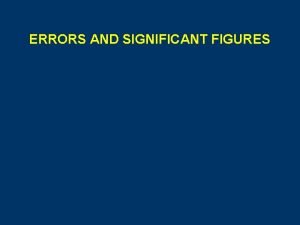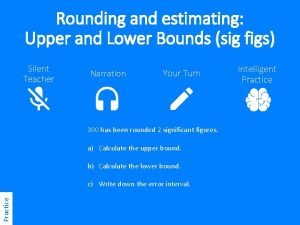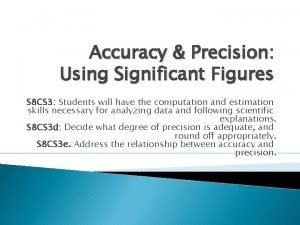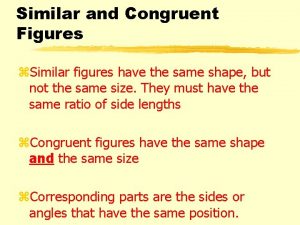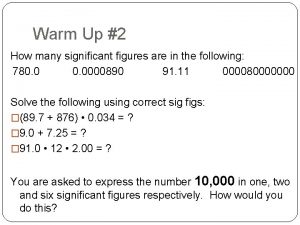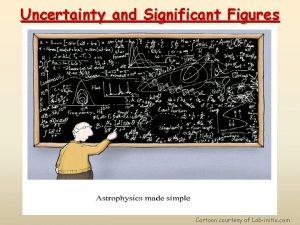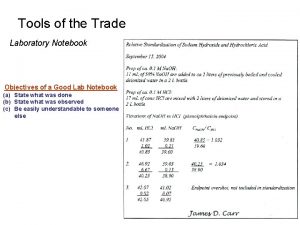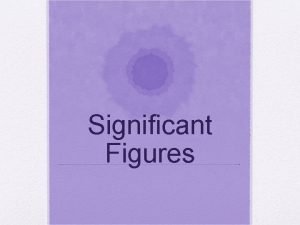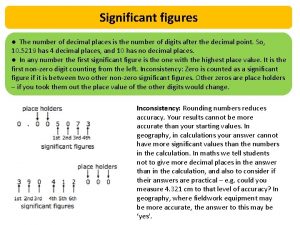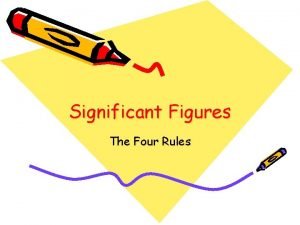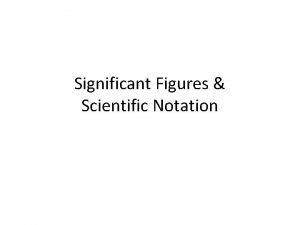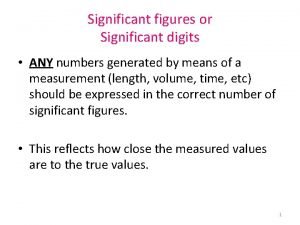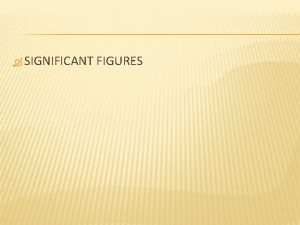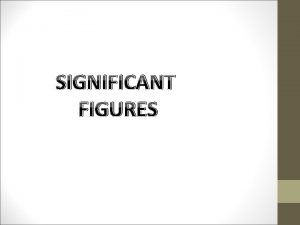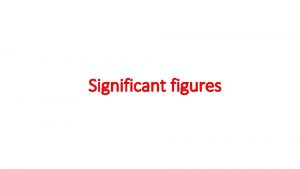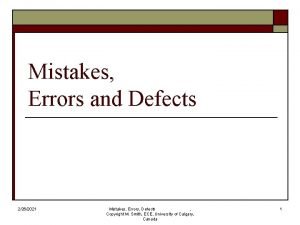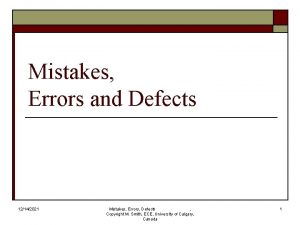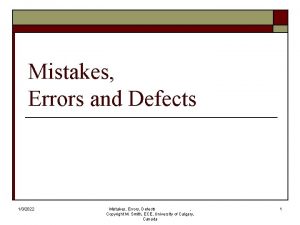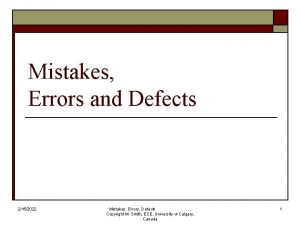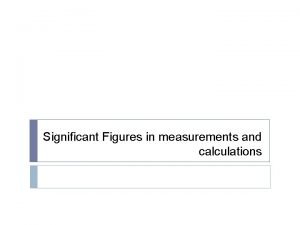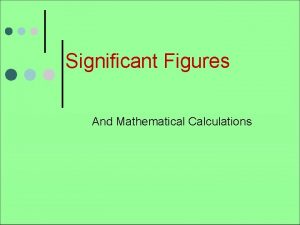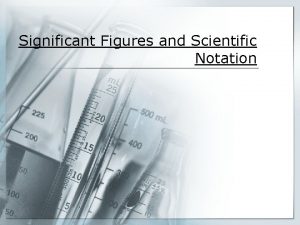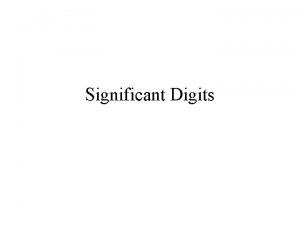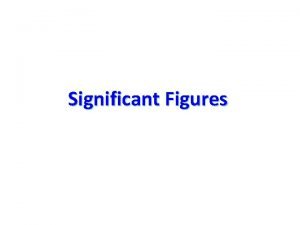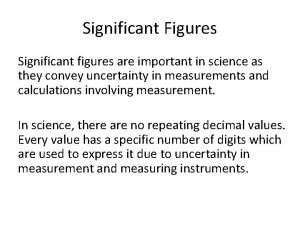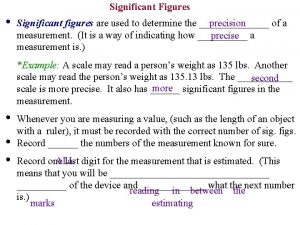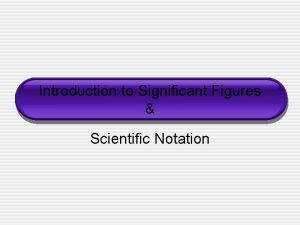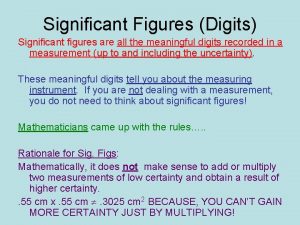ERRORS AND SIGNIFICANT FIGURES ERRORS Mistakes result of



















- Slides: 19

ERRORS AND SIGNIFICANT FIGURES

ERRORS • Mistakes - result of carelessness, easily detected • Errors - fall into two types, systematic or random

ERRORS • Systematic errors - due to imperfections in instruments and/or way experimenter does things • Random errors - due to limitations of the scale divisions of an instrument

SIGNIFICANT FIGURES • Retain as many figures as actually represent a measurement but no more. • Uncertain figure - last figure of a measurement estimated when using rulers and glassware

SIGNIFICANT FIGURES • 1. All nonzero numbers are significant figures.

SIGNIFICANT FIGURES • 2. Zeros that do not appear after some other digit are called leading zeros and are never significant.

SIGNIFICANT FIGURES • 3. Zeros surrounded by nonzeros are called captive zeros and are significant.

SIGNIFICANT FIGURES • 4. Zeros following a nonzero in a number with a decimal point are called trailing zeros and are significant.

SIGNIFICANT FIGURES • 5. In numbers larger than ten, use a decimal point to indicate if the trailing zeros are significant.

RULES FOR MATHEMATICAL OPERATIONS • When adding or subtracting, the smallest number of digits to the right of the decimal point determines the number of significant figures.

RULES FOR MATHEMATICAL OPERATIONS • When multiplying or dividing, the smaller number of significant figures of the two numbers is the number of significant figures the answer is expressed in.

ROUNDING RULES • Rule 1. If the first digit to the right of the last significant figure is less than five, the preceding digit is left unchanged.

ROUNDING RULES • Rule 2. If the digit to the right of the last uncertain digit is greater than five, the preceding digit is increased by one.

ROUNDING RULES • Rule 3. If the digit to the right of the last significant digit is five, the preceding digit is not changed if it is an even number and changed if it is an odd number.

ACCURACY • The accuracy of measurements is often expressed in terms of the percentage difference or percentage error.

ACCURACY • The percentage difference is often calculated in the absence of an accepted value. Percentage difference = difference x 100% average

ACCURACY • For example, two measurements of a hallway were 14. 2 m and 15. 1 m.

ACCURACY • Often, the accuracy obtained through laboratory measurements is determined by comparing the experimental values with standard values. Percentage error = error x 100% accepted value

ACCURACY For example, a meter stick is measured to be 1. 009 m long.
 Errors and significant figures
Errors and significant figures Lower bound 2 significant figures
Lower bound 2 significant figures Upper and lower bounds significant figures
Upper and lower bounds significant figures Precision and significant figures
Precision and significant figures Upper and lower bounds of rounded numbers
Upper and lower bounds of rounded numbers Similar figures are congruent
Similar figures are congruent Flat shape with eight sides
Flat shape with eight sides Pentagon plane figure or solid figure
Pentagon plane figure or solid figure Is ap chemistry hard
Is ap chemistry hard How many significant figures does 956 have
How many significant figures does 956 have Uncertainty rounding rules
Uncertainty rounding rules Sug figs
Sug figs Sig figs division
Sig figs division Significant figures ap chemistry
Significant figures ap chemistry What is significant figures in maths
What is significant figures in maths 820 m significant figures
820 m significant figures Significant figues
Significant figues Any non-zero number is always significant.
Any non-zero number is always significant. What are significant digits in math
What are significant digits in math Round off rule of 5
Round off rule of 5
